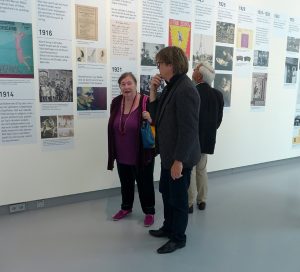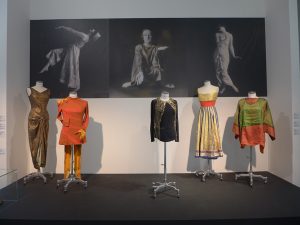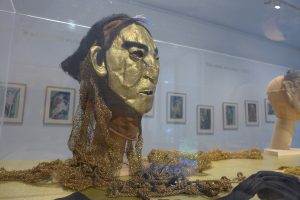In the first half of the 20th century, dance did not represent much in the Netherlands. There was some interest, but it exclusively concerned classical ballet. The successful dance performances all came from abroad.
It has all but disappeared from the history books that a remarkably creative and original dancer and choreographer settled in our country during those years: Gertrud Leistikow (1885 - 1948). One wonders what she was looking for here, in a land that was known as a marsh delta, but was a barren desert for the art of dance.
The cultural buitenplaats Kranenburgh in Bergen (NH) brings this extraordinary artist out of oblivion with the exhibition Pioneer of a new world. At the same time as the opening, the compiler of the exhibition, Jacobien de Boer, handed over the first copy of her book Dance fully, that's life to Leistikow's daughter-in-law Petra Kreb.

Dance is the most ephemeral of all art forms, at least at the time when Gertrud Leistikow flourished and when very little was captured on film. Some of her dance art was filmed, but these recordings have not survived. This will be one of the reasons why her name has disappeared from the collective memory. Leistikow's son Igor Jongman did reconstruct two of her works (the film footage can be seen on the wall of the exhibition), but you are left feeling uncertain whether you are really seeing what was happening on the dance floor at the time.

Leistikow railed against the restrictive tradition of classical ballet. It was a time when, globally, landslides in art history were taking place. Leistikow wanted freedom to develop her own movements. She introduced personal expression of emotions into her dance and, in order to do so, saw no objection to using movements that were considered 'not beautiful' at the time. There were more dancers in her time who pushed the boundaries in this way and initiated the breakthrough of modern dance, such as Isadora Duncan and Mary Wigman. The latter names have remained more famous than Leistikow's. Although we can no longer see Leistikow's dance, the exhibition gives the impression that she was at least as important for modern dance and the liberation of the body's possibilities of expression as the other innovators. Without Leistikow, Pina Bausch's work would be unthinkable.

The exhibition reveals the image of a highly versatile and innovative artist. Leistikow was not only a dancer, she had attended art school, painted and made designs. She also made the costumes and masks used in her choreographies herself. The photographs, posters and other visual material in the exhibition obviously show only still images, but it is clear from the passionate poses, masks and other props that Leistikow recognised no boundaries. The whole thing seriously raises the question of whether Leistikow was not as significant to modern dance as the other dance innovators of her time. But then again, perhaps it is not wise to live in the Netherlands in order to become truly famous. Leistikow also performed outside our country, certainly in the beginning with much more success than here.

That she enjoyed living and working in the Netherlands will have to do with the many contacts she had here in artist circles. She had a thriving teaching practice and counted many artists among her friends. The exhibition shows much of this, not only through photographs, but also with works of art. Jan Sluijters painted her. Mommie Schwarz made a calendar in 1925 with a drawing of a dancer in a Leistikow-inspired pose for each month. By Else Berg, a painting of Gertrud's son Igor can be seen. These are just a few examples. The pictures testify that she was in an engaged, often exuberantly festive environment. Security and inspiration is what she found there.
That an exhibition and a book have now been dedicated to Leistikow is not only deserved, it is also very interesting for the visitor to get an impression of the colourful life in artistic circles in Leistikow's days.
* Exhibition 'Pioneer of a new world. Gertrud Leistikow, a century of dance art', Kranenburgh, Bergen (NH), 1 July - 2 November 2014 (Mon. closed)
* Book: Jacobien de Boer, Dance fully, that's life. Gertrud Leistikow (1885 - 1948), pioneer of modern dance, Publisher The Art
